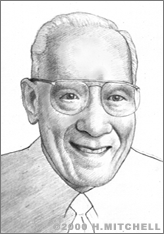Ernesto Blanco
Ernesto Blanco is one of the Massachusetts Institute of Technology's (MIT) leading teachers and practitioners of invention. Most of his over a dozen patented inventions have been in textile machinery, surgical apparatus, or devices that assist the physically challenged.
Blanco was born in 1922 and was raised in Havana, Cuba. He majored in Engineering at Havana University then worked as Chief Draftsman of Havana's City Planning Department before coming to the U.S. in 1949. Here he worked as Chief of Surveying for a firm in Albany, New York, while earning a BS in Mechanical Engineering at Rennselaer Polytechnic Institute in 1956.
Blanco then returned to Cuba to direct the School of Mechanical Engineering at Havana’s Universidad de Villanueva. In fact, Blanco designed the University's new laboratories and its new curriculum. In 1960, he returned to the U.S. While teaching engineering at MIT from 1960 to 1964 and at Tufts University from 1964 to 1969, he also helped the U.S. State Department develop Latin American cooperative engineering programs. In his own work, Blanco began to focus on industrial design.
By 1969, Blanco was a specialist in the design of textile machinery. He spent five years as a consultant before founding his own business, Universal Textile Corp., in 1974. Blanco's textile inventions include devices that detect faulty needles in knitting machines (patented 1977), center and spread out rolls of fabric, and control the tension of yarn during weaving. Blanco was also inventing in other areas. For example, under contract with the National Science Foundation, he designed the first of his many aids for the blind, a Braille Cell Display System.

In 1977, Blanco returned to MIT as an adjunct full professor in the Design Division of the Mechanical Engineering Department, teaching Engineering Design and Graphics, Kinematics, and "The Process of Innovation." Blanco was also a consultant to many major industrial and medical firms. As an inventor, Blanco continued to develop aids for the handicapped, especially the blind, as well as more strictly medical devices. He also produced an inexpensive solar power collector and even a solar-powered, kinetic sculpture, "Sun Wheel II."
Blanco's patented medical inventions include three surgical microstaplers (one for implanted corneas in 1990), an apparatus for monitoring medication delivery into the bloodstream (1992), an intraocular lens that can be pre-placed in the eye before cataract surgery (1991), and a three-dimensional robot-arm positioner for focused ultrasonic transducers (1993). Under contract, Blanco has also invented various instruments for noninvasive arthroscopic and ophthalmic microsurgery.
Blanco's first major invention for the handicapped was a stair-climbing wheelchair in 1962. A National Inventors Council contest offering a $5,000 prize for the first device of this type had been running since 1959 without receiving an entry that actually worked. Blanco's did. His model had a set of retractable, spring-loaded spokes that could extend beyond the wheel rim to function as pinions, keeping the chair upright as it was powered up the stairs.
Blanco has also designed many improvements to Braille writing machines. Because each letter of the Braille alphabet requires a pattern of one to six indentations, Braille typewriters can be very fatiguing to use. While teaching at Tufts, Blanco designed a model that provided electric power for the embossing force and applied the force only once per letter rather than once per indentation. Blanco's Braille typewriter was commercialized and is still widely used today.
Ernesto Blanco was one of MIT's most highly respected, creative thinkers, and teachers. He passed away on March 21, 2017 at the age of 94 in Murrieta, California.


